Page 145 of 204

SCHEDULED SERVICING PLAN (2.2 JTD diesel engine versions)
The checks listed in the Scheduled Servicing Plan, after reaching 120,000 mi (200,000 km)/10 years, must be cyclically repeated
starting from the first interval, thus following the same intervals as before.
Thousands of miles12 24 36 48 60 72 84 96 108 120
Thousands of kilometres20 40 60 80 100 120 140 160 180 200
Years12345678910
Check battery charge status with the proper instrument●●●●●●●●●●
Check tyre condition/wear and adjust pressure, if necessary.
Check the Tyre Repair Kit recharge condition and expiry date●●●●●●●●●●
Check operation of lighting system (headlights, direction
indicators, hazard warning lights, boot, passenger
compartment, glove compartment, instrument panel warning
lights, etc.)
●●●●●●●●●●
Check and, if necessary, top up fluid levels (1)●●●●●●●●●●
Check exhaust emissions/smokiness●●●●●●●●●●
Use the diagnosis socket to check supply/engine
management systems operation, emissions and, for
versions/markets, where provided, engine oil degradation (2)
●●●●●●●●●●
Visually inspect conditions of: exterior bodywork, underbody
protection, pipes and hoses (exhaust, fuel system, brakes),
rubber elements (gaiters, sleeves, bushes, etc.)
●●●●●
Check position/wear of front windscreen wiper blade●●●●●
(1) Top up using the fluids indicated in the “Fluids and lubricants” paragraph of the “Technical data” chapter and only after checking that the system is
intact.
(2) If the vehicle diagnostics shows the oil to be degraded to less than 20%, replacing the engine oil and filter is advised.
143
Page 146 of 204
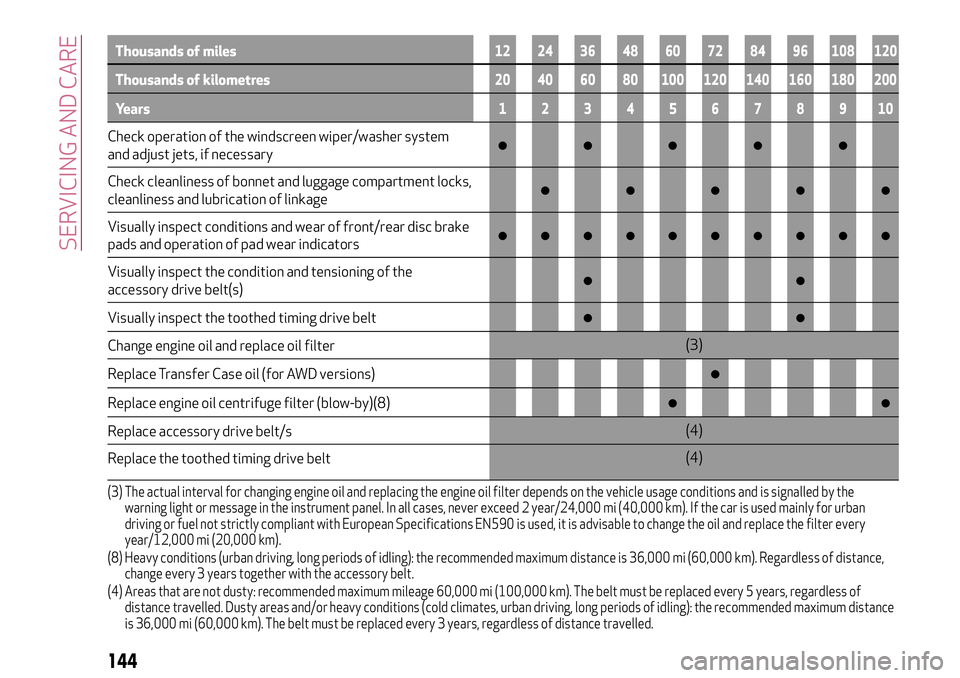
Thousands of miles12 24 36 48 60 72 84 96 108 120
Thousands of kilometres20 40 60 80 100 120 140 160 180 200
Years12345678910
Check operation of the windscreen wiper/washer system
and adjust jets, if necessary●●●●●
Check cleanliness of bonnet and luggage compartment locks,
cleanliness and lubrication of linkage●●●●●
Visually inspect conditions and wear of front/rear disc brake
pads and operation of pad wear indicators●●●●●●●●●●
Visually inspect the condition and tensioning of the
accessory drive belt(s)●●
Visually inspect the toothed timing drive belt●●
Change engine oil and replace oil filter(3)
Replace Transfer Case oil (for AWD versions)
●
Replace engine oil centrifuge filter (blow-by)(8)●●
Replace accessory drive belt/s(4)
Replace the toothed timing drive belt(4)
(3) The actual interval for changing engine oil and replacing the engine oil filter depends on the vehicle usage conditions and is signalled by the
warning light or message in the instrument panel. In all cases, never exceed 2 year/24,000 mi (40,000 km). If the car is used mainly for urban
driving or fuel not strictly compliant with European Specifications EN590 is used, it is advisable to change the oil and replace the filter every
year/12,000 mi (20,000 km).
(8) Heavy conditions (urban driving, long periods of idling): the recommended maximum distance is 36,000 mi (60,000 km). Regardless of distance,
change every 3 years together with the accessory belt.
(4) Areas that are not dusty: recommended maximum mileage 60,000 mi (100,000 km). The belt must be replaced every 5 years, regardless of
distance travelled. Dusty areas and/or heavy conditions (cold climates, urban driving, long periods of idling): the recommended maximum distance
is 36,000 mi (60,000 km). The belt must be replaced every 3 years, regardless of distance travelled.
144
SERVICING AND CARE
Page 147 of 204
Thousands of miles12 24 36 48 60 72 84 96 108 120
Thousands of kilometres20 40 60 80 100 120 140 160 180 200
Years12345678910
Replace air cleaner cartridge (5)●●●
Replace fuel filter cartridge (7)●●●
Change the brake fluid(6)
Replace the passenger compartment cleaner
●●●●●●●●●●
(5) If the vehicle is used in dusty areas, this cleaner must be replaced every 12,000 mi (20,000 km).
(7) If the vehicle runs on fuel with quality below the relevant European specification, this filter must be replaced every 12,000 mi (20,000 km)
(6) The brake fluid replacement has to be done every two years, irrespective of the mileage.
(●) Mandatory operations
145
Page 148 of 204
ENGINE COMPARTMENT
CHECKING LEVELS
142) 143)
55)
Diesel versions - 2.2 JTD engine,fig. 148
1. Engine oil filler 2. Engine coolant reservoir plug 3. Brake fluid reservoir plug access cover 4. Windscreen/headlights washer
fluid reservoir plug
14809026S0503EM
146
SERVICING AND CARE
Page 149 of 204

ENGINE OIL
144)
56)
The engine oil level can be seen on the
instrument panel display every time the
engine is started, or on the Connect
system display by activating on the main
menu (MENU button) the following
functions in sequence: “Apps”; “My Car”
and “Oil Level”.
The oil level can also be checked
manually.
Manual gearbox: checking oil level
2.2 JTD Engine
Have this operation performed at an Alfa
Romeo Dealership.
Engine oil consumption
57)
4)
The maximum engine oil consumption is
usually 0.55 pounds (250 grams) every
620 mi (1,000 km). When the vehicle is
new, the engine needs to be run in;
therefore the engine oil consumption can
only be considered stabilised after the
first 3,100 - 3,730 mi (5,000 -
6,000 km).
ENGINE COOLANT FLUID
145)
58)
If the level is too low, unscrew the cap of
reservoir 2 and add the fluid described in
the "Technical Specifications" chapter.
WASHER FLUID FOR WINDSCREEN/
HEADLIGHTS
146) 147)
The windscreen and headlights washer
fluid reservoir (where available) is
equipped with a telescopic filler.
If the level is too low, remove reservoir
cap 4 and lift the filler then add the fluid
described in the "Technical
Specifications" chapter.
IMPORTANT The headlight washing
system will not work if the liquid level is
low (situation indicated by the symbol on
the instrument panel display). The
windscreen washer will keep working. On
vehicles equipped with headlight
washers, Where provided, there is a
reference notch on the dipstick: ONLY
the windscreen/rear window washer
operates with the level below this
reference.
BRAKE FLUID
Check that the fluid is at the max. level. If
the liquid level in the tank is insufficient,
contact an Alfa Romeo Dealership to
have the system checked.
AUTOMATIC TRANSMISSION
ACTIVATIONSYSTEM OIL
4)
The transmission control oil level should
only be checked at an Alfa Romeo
Dealership.
USEFUL ADVICE FOR EXTENDING THE
LIFE OF YOUR BATTERY
Useful advice for extending the life of
your battery
To avoid draining your battery and make
it last longer, observe the following
instructions:
when you park the car, ensure that the
doors, tailgate and bonnet are closed
properly, to prevent any lights from
remaining on inside the passenger's
compartment;
switch off all roof lights inside the car:
the car is however equipped with a
system which switches all internal lights
off automatically;
do not keep accessories (e.g. radio,
hazard warning lights, etc.) switched on
for a long time when the engine is not
running;
before performing any operation on
the electrical system, disconnect the
negative battery cable.
If, after purchasing the car, you wish to
install electrical accessories which
require permanent electrical supply (e.g.
alarm, etc.) or accessories which
147
Page 150 of 204
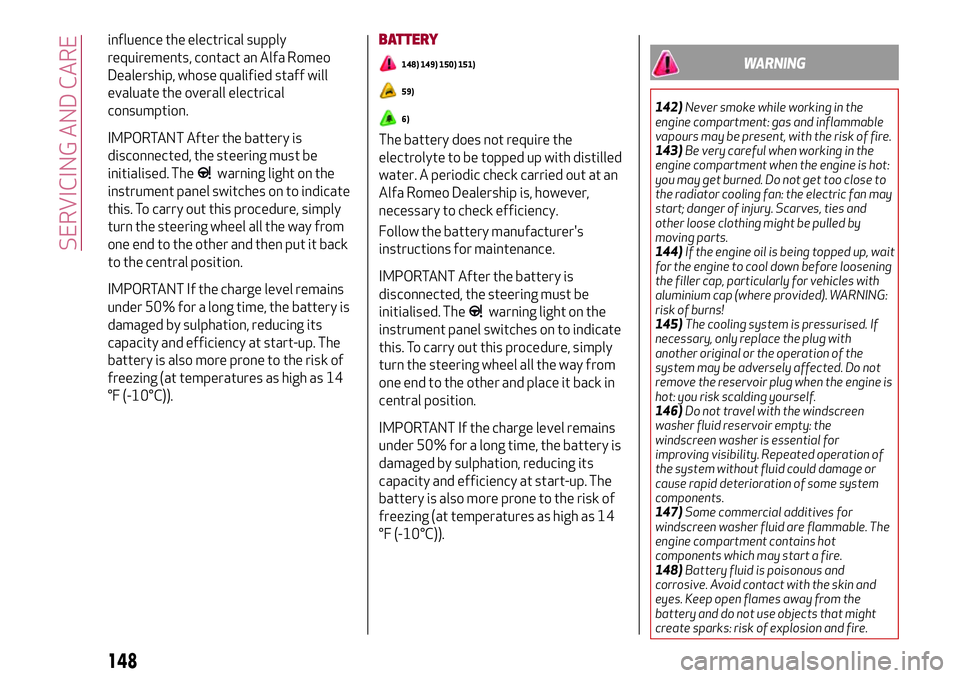
influence the electrical supply
requirements, contact an Alfa Romeo
Dealership, whose qualified staff will
evaluate the overall electrical
consumption.
IMPORTANT After the battery is
disconnected, the steering must be
initialised. The
warning light on the
instrument panel switches on to indicate
this. To carry out this procedure, simply
turn the steering wheel all the way from
one end to the other and then put it back
to the central position.
IMPORTANT If the charge level remains
under 50% for a long time, the battery is
damaged by sulphation, reducing its
capacity and efficiency at start-up. The
battery is also more prone to the risk of
freezing (at temperatures as high as 14
°F (-10°C)).BATTERY
148) 149) 150) 151)
59)
6)
The battery does not require the
electrolyte to be topped up with distilled
water. A periodic check carried out at an
Alfa Romeo Dealership is, however,
necessary to check efficiency.
Follow the battery manufacturer's
instructions for maintenance.
IMPORTANT After the battery is
disconnected, the steering must be
initialised. The
warning light on the
instrument panel switches on to indicate
this. To carry out this procedure, simply
turn the steering wheel all the way from
one end to the other and place it back in
central position.
IMPORTANT If the charge level remains
under 50% for a long time, the battery is
damaged by sulphation, reducing its
capacity and efficiency at start-up. The
battery is also more prone to the risk of
freezing (at temperatures as high as 14
°F (-10°C)).
WARNING
142)Never smoke while working in the
engine compartment: gas and inflammable
vapours may be present, with the risk of fire.
143)Be very careful when working in the
engine compartment when the engine is hot:
you may get burned. Do not get too close to
the radiator cooling fan: the electric fan may
start; danger of injury. Scarves, ties and
other loose clothing might be pulled by
moving parts.
144)If the engine oil is being topped up, wait
for the engine to cool down before loosening
the filler cap, particularly for vehicles with
aluminium cap (where provided). WARNING:
risk of burns!
145)The cooling system is pressurised. If
necessary, only replace the plug with
another original or the operation of the
system may be adversely affected. Do not
remove the reservoir plug when the engine is
hot: you risk scalding yourself.
146)Do not travel with the windscreen
washer fluid reservoir empty: the
windscreen washer is essential for
improving visibility. Repeated operation of
the system without fluid could damage or
cause rapid deterioration of some system
components.
147)Some commercial additives for
windscreen washer fluid are flammable. The
engine compartment contains hot
components which may start a fire.
148)Battery fluid is poisonous and
corrosive. Avoid contact with the skin and
eyes. Keep open flames away from the
battery and do not use objects that might
create sparks: risk of explosion and fire.
148
SERVICING AND CARE
Page 151 of 204
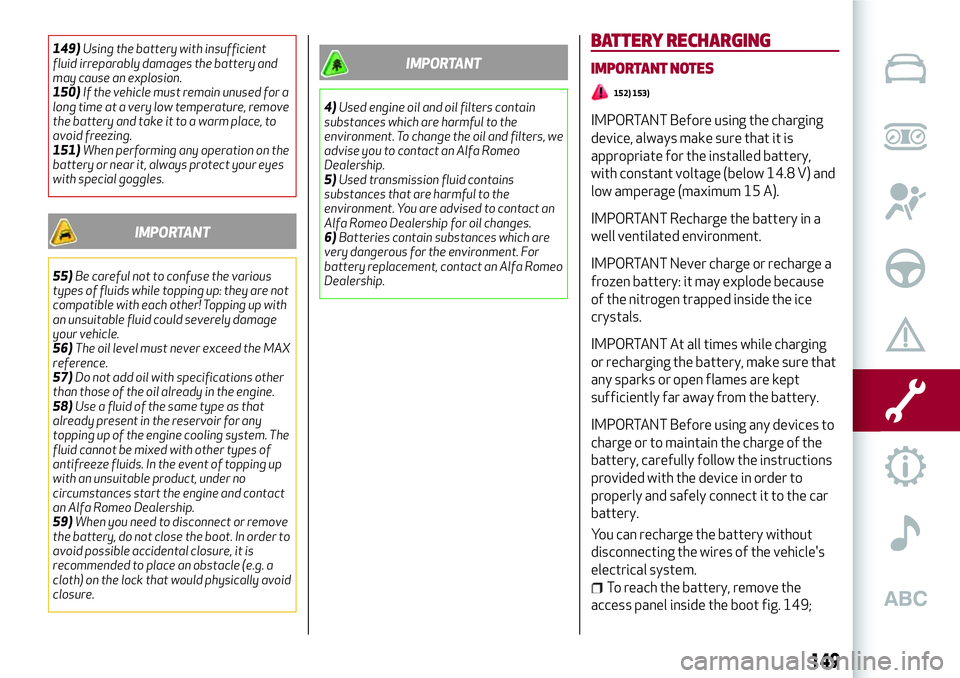
149)Using the battery with insufficient
fluid irreparably damages the battery and
may cause an explosion.
150)If the vehicle must remain unused for a
long time at a very low temperature, remove
the battery and take it to a warm place, to
avoid freezing.
151)When performing any operation on the
battery or near it, always protect your eyes
with special goggles.
IMPORTANT
55)Be careful not to confuse the various
types of fluids while topping up: they are not
compatible with each other! Topping up with
an unsuitable fluid could severely damage
your vehicle.
56)The oil level must never exceed the MAX
reference.
57)Do not add oil with specifications other
than those of the oil already in the engine.
58)Use a fluid of the same type as that
already present in the reservoir for any
topping up of the engine cooling system. The
fluid cannot be mixed with other types of
antifreeze fluids. In the event of topping up
with an unsuitable product, under no
circumstances start the engine and contact
an Alfa Romeo Dealership.
59)When you need to disconnect or remove
the battery, do not close the boot. In order to
avoid possible accidental closure, it is
recommended to place an obstacle (e.g. a
cloth) on the lock that would physically avoid
closure.
IMPORTANT
4)Used engine oil and oil filters contain
substances which are harmful to the
environment. To change the oil and filters, we
advise you to contact an Alfa Romeo
Dealership.
5)Used transmission fluid contains
substances that are harmful to the
environment. You are advised to contact an
Alfa Romeo Dealership for oil changes.
6)Batteries contain substances which are
very dangerous for the environment. For
battery replacement, contact an Alfa Romeo
Dealership.
BATTERY RECHARGING
IMPORTANT NOTES
152) 153)
IMPORTANT Before using the charging
device, always make sure that it is
appropriate for the installed battery,
with constant voltage (below 14.8 V) and
low amperage (maximum 15 A).
IMPORTANT Recharge the battery in a
well ventilated environment.
IMPORTANT Never charge or recharge a
frozen battery: it may explode because
of the nitrogen trapped inside the ice
crystals.
IMPORTANT At all times while charging
or recharging the battery, make sure that
any sparks or open flames are kept
sufficiently far away from the battery.
IMPORTANT Before using any devices to
charge or to maintain the charge of the
battery, carefully follow the instructions
provided with the device in order to
properly and safely connect it to the car
battery.
You can recharge the battery without
disconnecting the wires of the vehicle's
electrical system.
To reach the battery, remove the
access panel inside the boot fig. 149;
149
Page 152 of 204

remove the protective cover 1
fig. 150 and connect the positive cable
terminal of the charger (usually red) to
the positive terminal (+) of the battery;
connect the negative terminal of the
charger (usually black) to nut 2 next to
the negative terminal (-) of the battery, as
shown in fig. 150;
The vehicle is equipped with an IBS
(Intelligent Battery Sensor), which is ableto measure the charge and discharge
voltage and calculate the charge level
and the general condition of the battery.
The sensor is placed next to the negative
terminal (-) of the battery.
For a correct charge/discharge
procedure, the charge voltage must go
through the IBS sensor.
Turn the charger on and follow the
instructions on the user's manual to
completely recharge the battery;
when the battery is charged, turn the
charger off before disconnecting it from
the battery;
first disconnect the black cable
terminal of the battery charger and then
the red cable terminal;
refit the protective cover of the
positive terminal of the battery and the
access cover to the battery
compartment.
IMPORTANT If a "quick-type" battery
charger is used with the battery fitted on
the vehicle, before connecting it
disconnect both cables of the battery
itself. Do not use a "quick-type" battery
charger to provide the starting voltage.
60)
WARNING
152)The process of charging or recharging
the battery produces hydrogen, a flammable
gas that can explode and cause serious
injury.
153)When charging or recharging the
battery, always follow the precautions
listed.
IMPORTANT
60)When you need to disconnect or remove
the battery, do not close the boot. In order to
avoid possible accidental closure, it is
recommended to place an obstacle (e.g. a
cloth) on the lock that would physically avoid
closure.
14909036S0001EM
15009036S0002EM
150
SERVICING AND CARE
 1
1 2
2 3
3 4
4 5
5 6
6 7
7 8
8 9
9 10
10 11
11 12
12 13
13 14
14 15
15 16
16 17
17 18
18 19
19 20
20 21
21 22
22 23
23 24
24 25
25 26
26 27
27 28
28 29
29 30
30 31
31 32
32 33
33 34
34 35
35 36
36 37
37 38
38 39
39 40
40 41
41 42
42 43
43 44
44 45
45 46
46 47
47 48
48 49
49 50
50 51
51 52
52 53
53 54
54 55
55 56
56 57
57 58
58 59
59 60
60 61
61 62
62 63
63 64
64 65
65 66
66 67
67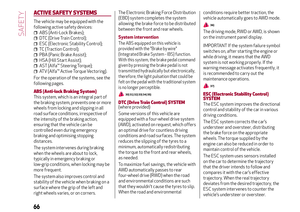 68
68 69
69 70
70 71
71 72
72 73
73 74
74 75
75 76
76 77
77 78
78 79
79 80
80 81
81 82
82 83
83 84
84 85
85 86
86 87
87 88
88 89
89 90
90 91
91 92
92 93
93 94
94 95
95 96
96 97
97 98
98 99
99 100
100 101
101 102
102 103
103 104
104 105
105 106
106 107
107 108
108 109
109 110
110 111
111 112
112 113
113 114
114 115
115 116
116 117
117 118
118 119
119 120
120 121
121 122
122 123
123 124
124 125
125 126
126 127
127 128
128 129
129 130
130 131
131 132
132 133
133 134
134 135
135 136
136 137
137 138
138 139
139 140
140 141
141 142
142 143
143 144
144 145
145 146
146 147
147 148
148 149
149 150
150 151
151 152
152 153
153 154
154 155
155 156
156 157
157 158
158 159
159 160
160 161
161 162
162 163
163 164
164 165
165 166
166 167
167 168
168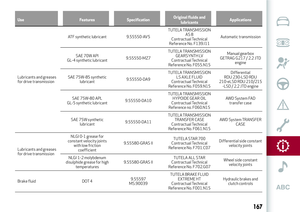 169
169 170
170 171
171 172
172 173
173 174
174 175
175 176
176 177
177 178
178 179
179 180
180 181
181 182
182 183
183 184
184 185
185 186
186 187
187 188
188 189
189 190
190 191
191 192
192 193
193 194
194 195
195 196
196 197
197 198
198 199
199 200
200 201
201 202
202 203
203






